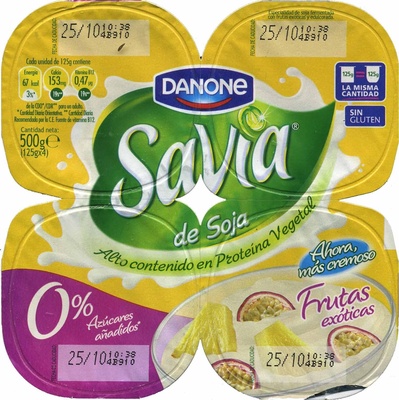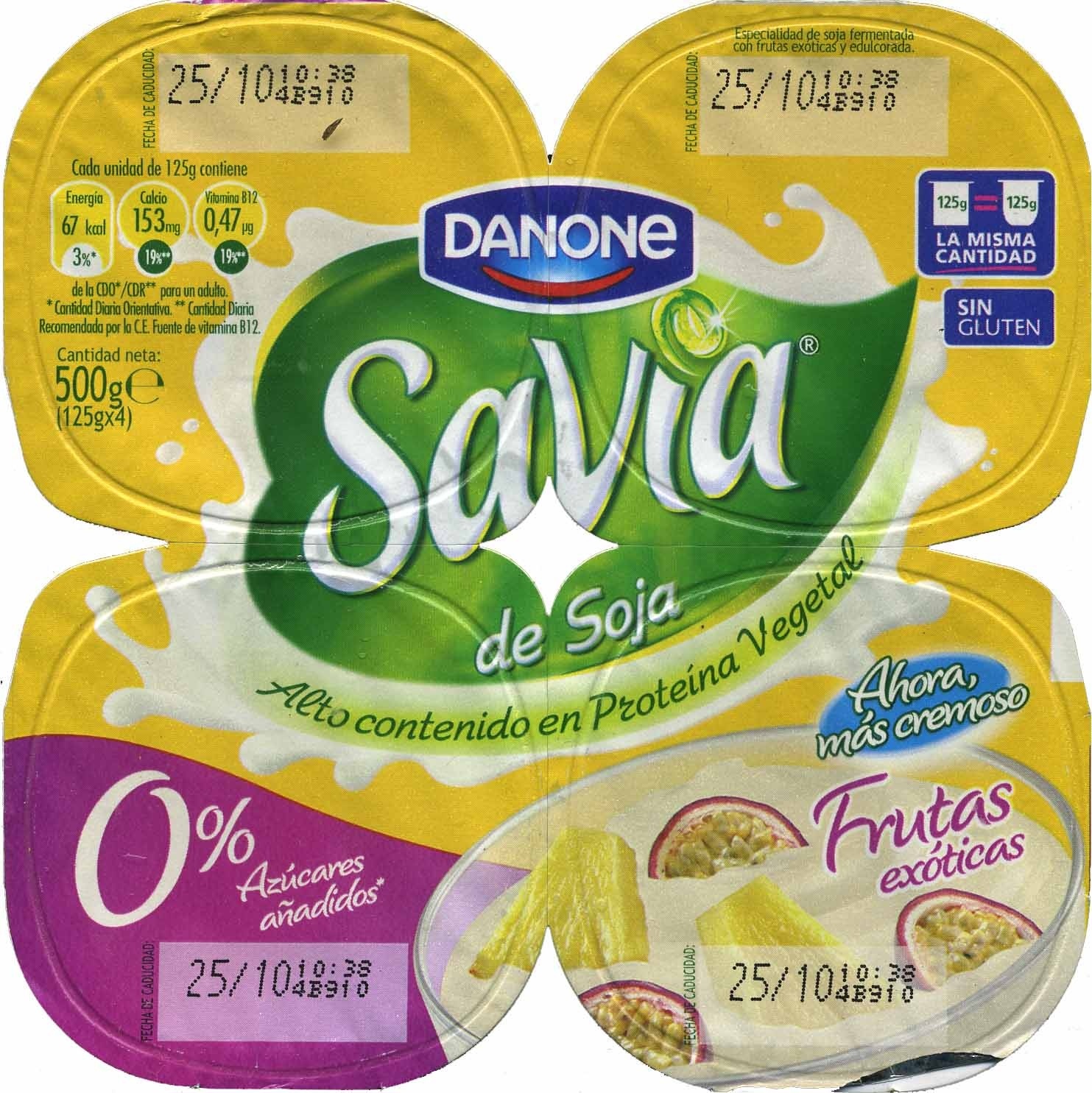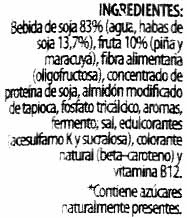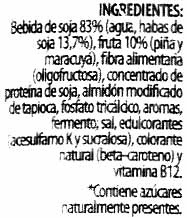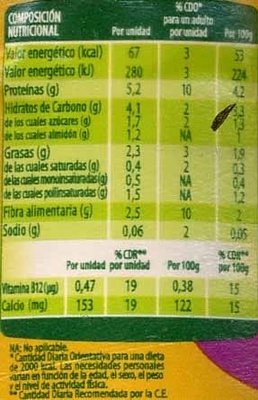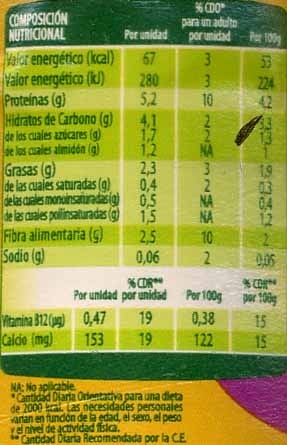Help us make food transparency the norm!
As a non-profit organization, we depend on your donations to continue informing consumers around the world about what they eat.
The food revolution starts with you!
Postre de soja Savia frutas exóticas edulcorado - DESCATALOGADO - Danone - 500 g (4 x 125 g)
Postre de soja Savia frutas exóticas edulcorado - DESCATALOGADO - Danone - 500 g (4 x 125 g)
This product page is not complete. You can help to complete it by editing it and adding more data from the photos we have, or by taking more photos using the app for Android or iPhone/iPad. Thank you!
×
Barcode: 8410500009403 (EAN / EAN-13)
Common name: Postre de soja con frutas exóticas y edulcorantes
Quantity: 500 g (4 x 125 g)
Packaging: Refrigerated, es:Tarrina de plástico
Brands: Danone
Categories: Plant-based foods and beverages, Fermented foods, Dairy substitutes, Desserts, Non-dairy desserts, Non-dairy fermented foods, Non-dairy yogurts, Soy milk yogurts, Fruit soy yogurts, Mixed fruit soy yogurts, Tropical fruits soy yogurts
Labels, certifications, awards: No gluten, Vegetarian, No GMOs, Vegan
Manufacturing or processing places: Parets del Vallés, Barcelona (provincia), Cataluña, España
Traceability code: ES 26.02159/B C CE, FABRICANTE Y ENVASADOR:, DANONE S.A., PERTENECIENTE A:, GROUPE DANONE S.A.
Link to the product page on the official site of the producer: http://www.danone.es/Producto/savia/
Stores: Mercadona, Carrefour, AhorraMas
Countries where sold: Spain
Matching with your preferences
Health
Ingredients
-
24 ingredients
: Bebida de soja 83% (agua, habas de soja 13,7%), fruta 10% (piña y maracuyá), fibra alimentaria (oligofructosa), concentrado de proteína de soja, almidón modificado de tapioca, fosfato tricálcico (E-341iii), aromas, fermento, sal, edulcorantes: acesulfamo K (E-950) y sucralosa (E-955), colorante natural: betacaroteno (E-160a) y vitamina B12.Allergens: Soybeans
Food processing
-
Ultra processed foods
Elements that indicate the product is in the 4 - Ultra processed food and drink products group:
- Additive: E14XX - Modified Starch
- Additive: E160a - Carotene
- Additive: E950 - Acesulfame k
- Additive: E955 - Sucralose
- Ingredient: Colour
- Ingredient: Flavouring
- Ingredient: Sweetener
Food products are classified into 4 groups according to their degree of processing:
- Unprocessed or minimally processed foods
- Processed culinary ingredients
- Processed foods
- Ultra processed foods
The determination of the group is based on the category of the product and on the ingredients it contains.
Additives
-
E160a - Carotene
Carotene: The term carotene -also carotin, from the Latin carota, "carrot"- is used for many related unsaturated hydrocarbon substances having the formula C40Hx, which are synthesized by plants but in general cannot be made by animals -with the exception of some aphids and spider mites which acquired the synthesizing genes from fungi-. Carotenes are photosynthetic pigments important for photosynthesis. Carotenes contain no oxygen atoms. They absorb ultraviolet, violet, and blue light and scatter orange or red light, and -in low concentrations- yellow light. Carotenes are responsible for the orange colour of the carrot, for which this class of chemicals is named, and for the colours of many other fruits, vegetables and fungi -for example, sweet potatoes, chanterelle and orange cantaloupe melon-. Carotenes are also responsible for the orange -but not all of the yellow- colours in dry foliage. They also -in lower concentrations- impart the yellow coloration to milk-fat and butter. Omnivorous animal species which are relatively poor converters of coloured dietary carotenoids to colourless retinoids have yellowed-coloured body fat, as a result of the carotenoid retention from the vegetable portion of their diet. The typical yellow-coloured fat of humans and chickens is a result of fat storage of carotenes from their diets. Carotenes contribute to photosynthesis by transmitting the light energy they absorb to chlorophyll. They also protect plant tissues by helping to absorb the energy from singlet oxygen, an excited form of the oxygen molecule O2 which is formed during photosynthesis. β-Carotene is composed of two retinyl groups, and is broken down in the mucosa of the human small intestine by β-carotene 15‚15'-monooxygenase to retinal, a form of vitamin A. β-Carotene can be stored in the liver and body fat and converted to retinal as needed, thus making it a form of vitamin A for humans and some other mammals. The carotenes α-carotene and γ-carotene, due to their single retinyl group -β-ionone ring-, also have some vitamin A activity -though less than β-carotene-, as does the xanthophyll carotenoid β-cryptoxanthin. All other carotenoids, including lycopene, have no beta-ring and thus no vitamin A activity -although they may have antioxidant activity and thus biological activity in other ways-. Animal species differ greatly in their ability to convert retinyl -beta-ionone- containing carotenoids to retinals. Carnivores in general are poor converters of dietary ionone-containing carotenoids. Pure carnivores such as ferrets lack β-carotene 15‚15'-monooxygenase and cannot convert any carotenoids to retinals at all -resulting in carotenes not being a form of vitamin A for this species-; while cats can convert a trace of β-carotene to retinol, although the amount is totally insufficient for meeting their daily retinol needs.Source: Wikipedia
-
E160ai - Beta-carotene
Beta-Carotene: β-Carotene is an organic, strongly colored red-orange pigment abundant in plants and fruits. It is a member of the carotenes, which are terpenoids -isoprenoids-, synthesized biochemically from eight isoprene units and thus having 40 carbons. Among the carotenes, β-carotene is distinguished by having beta-rings at both ends of the molecule. β-Carotene is biosynthesized from geranylgeranyl pyrophosphate.β-Carotene is the most common form of carotene in plants. When used as a food coloring, it has the E number E160a. The structure was deduced by Karrer et al. in 1930. In nature, β-carotene is a precursor -inactive form- to vitamin A via the action of beta-carotene 15‚15'-monooxygenase.Isolation of β-carotene from fruits abundant in carotenoids is commonly done using column chromatography. It can also be extracted from the beta-carotene rich algae, Dunaliella salina. The separation of β-carotene from the mixture of other carotenoids is based on the polarity of a compound. β-Carotene is a non-polar compound, so it is separated with a non-polar solvent such as hexane. Being highly conjugated, it is deeply colored, and as a hydrocarbon lacking functional groups, it is very lipophilic.Source: Wikipedia
-
E950 - Acesulfame k
Acesulfame potassium: Acesulfame potassium - AY-see-SUL-faym-, also known as acesulfame K -K is the symbol for potassium- or Ace K, is a calorie-free sugar substitute -artificial sweetener- often marketed under the trade names Sunett and Sweet One. In the European Union, it is known under the E number -additive code- E950. It was discovered accidentally in 1967 by German chemist Karl Clauss at Hoechst AG -now Nutrinova-. In chemical structure, acesulfame potassium is the potassium salt of 6-methyl-1‚2,3-oxathiazine-4-3H--one 2‚2-dioxide. It is a white crystalline powder with molecular formula C4H4KNO4S and a molecular weight of 201.24 g/mol.Source: Wikipedia
-
E955 - Sucralose
Sucralose: Sucralose is an artificial sweetener and sugar substitute. The majority of ingested sucralose is not broken down by the body, so it is noncaloric. In the European Union, it is also known under the E number E955. It is produced by chlorination of sucrose. Sucralose is about 320 to 1‚000 times sweeter than sucrose, three times as sweet as both aspartame and acesulfame potassium, and twice as sweet as sodium saccharin. Evidence of benefit is lacking for long-term weight loss with some data supporting weight gain and heart disease risks.It is stable under heat and over a broad range of pH conditions. Therefore, it can be used in baking or in products that require a long shelf life. The commercial success of sucralose-based products stems from its favorable comparison to other low-calorie sweeteners in terms of taste, stability, and safety. Common brand names of sucralose-based sweeteners are Splenda, Zerocal, Sukrana, SucraPlus, Candys, Cukren, and Nevella. Canderel Yellow also contains sucralose, but the original Canderel and Green Canderel do not.Source: Wikipedia
Ingredients analysis
-
May contain palm oil
Ingredients that may contain palm oil: E160a
-
Vegan
No non-vegan ingredients
Unrecognized ingredients: Fiber, Vitamin b12
-
Vegetarian
No non-vegetarian ingredients detected
Unrecognized ingredients: Fiber, Vitamin b12
-
Details of the analysis of the ingredients
: Bebida de soja 83% (agua, habas de soja 13.7%), fruta 10% (piña, maracuyá), fibra alimentaria (oligofructosa), de proteína de soja, almidón modificado de tapioca, fosfato tricálcico (e341iii), aromas, fermento, sal, edulcorantes (acesulfamo K (e950)), sucralosa (e955), colorante natural (betacaroteno (e160a)), vitamina B12- Bebida de soja -> en:soy-milk - vegan: yes - vegetarian: yes - percent_min: 83 - percent: 83 - percent_max: 83
- agua -> en:water - vegan: yes - vegetarian: yes - ciqual_food_code: 18066 - percent_min: 69.3 - percent_max: 69.3
- habas de soja -> en:soya-bean - vegan: yes - vegetarian: yes - ciqual_food_code: 20901 - percent_min: 13.7 - percent: 13.7 - percent_max: 13.7
- fruta -> en:fruit - vegan: yes - vegetarian: yes - percent_min: 10 - percent: 10 - percent_max: 10
- piña -> en:pineapple - vegan: yes - vegetarian: yes - percent_min: 5 - percent_max: 10
- maracuyá -> en:passionfruit - vegan: yes - vegetarian: yes - ciqual_food_code: 13016 - percent_min: 0 - percent_max: 5
- fibra alimentaria -> en:fiber - percent_min: 0.636363636363636 - percent_max: 7
- oligofructosa -> en:oligofructose - vegan: yes - vegetarian: yes - percent_min: 0.636363636363636 - percent_max: 7
- de proteína de soja -> en:soy-protein - vegan: yes - vegetarian: yes - ciqual_food_code: 20591 - percent_min: 0 - percent_max: 3.5
- almidón modificado de tapioca -> en:modified-tapioca-starch - vegan: yes - vegetarian: yes - ciqual_proxy_food_code: 9510 - percent_min: 0 - percent_max: 2.33333333333333
- fosfato tricálcico -> en:e341iii - vegan: yes - vegetarian: yes - percent_min: 0 - percent_max: 1.75
- e341iii -> en:e341iii - vegan: yes - vegetarian: yes - percent_min: 0 - percent_max: 1.75
- aromas -> en:flavouring - vegan: maybe - vegetarian: maybe - percent_min: 0 - percent_max: 1.4
- fermento -> en:ferment - vegan: maybe - vegetarian: maybe - percent_min: 0 - percent_max: 1.16666666666667
- sal -> en:salt - vegan: yes - vegetarian: yes - ciqual_food_code: 11058 - percent_min: 0 - percent_max: 0.127
- edulcorantes -> en:sweetener - percent_min: 0 - percent_max: 0.127
- acesulfamo K -> en:e950 - vegan: yes - vegetarian: yes - percent_min: 0 - percent_max: 0.127
- e950 -> en:e950 - vegan: yes - vegetarian: yes - percent_min: 0 - percent_max: 0.127
- acesulfamo K -> en:e950 - vegan: yes - vegetarian: yes - percent_min: 0 - percent_max: 0.127
- sucralosa -> en:e955 - vegan: yes - vegetarian: yes - percent_min: 0 - percent_max: 0.127
- e955 -> en:e955 - vegan: yes - vegetarian: yes - percent_min: 0 - percent_max: 0.127
- colorante natural -> en:natural-colours - percent_min: 0 - percent_max: 0.127
- betacaroteno -> en:e160ai - vegan: maybe - vegetarian: maybe - from_palm_oil: maybe - percent_min: 0 - percent_max: 0.127
- e160a -> en:e160a - vegan: maybe - vegetarian: maybe - from_palm_oil: maybe - percent_min: 0 - percent_max: 0.127
- betacaroteno -> en:e160ai - vegan: maybe - vegetarian: maybe - from_palm_oil: maybe - percent_min: 0 - percent_max: 0.127
- vitamina B12 -> en:vitamin-b12 - percent_min: 0 - percent_max: 0.127
- Bebida de soja -> en:soy-milk - vegan: yes - vegetarian: yes - percent_min: 83 - percent: 83 - percent_max: 83
Nutrition
-
Very good nutritional quality
⚠ ️Warning: the amount of fruits, vegetables and nuts is not specified on the label, it was estimated from the list of ingredients: 23This product is not considered a beverage for the calculation of the Nutri-Score.
Positive points: 4
- Proteins: 2 / 5 (value: 4.2, rounded value: 4.2)
- Fiber: 2 / 5 (value: 2, rounded value: 2)
- Fruits, vegetables, nuts, and colza/walnut/olive oils: 0 / 5 (value: 23.7, rounded value: 23.7)
Negative points: 0
- Energy: 0 / 10 (value: 224, rounded value: 224)
- Sugars: 0 / 10 (value: 1.3, rounded value: 1.3)
- Saturated fat: 0 / 10 (value: 0.3, rounded value: 0.3)
- Sodium: 0 / 10 (value: 50.8, rounded value: 50.8)
The points for proteins are counted because the negative points are less than 11.
Nutritional score: (0 - 4)
Nutri-Score:
-
Nutrient levels
-
Fat in low quantity (1.9%)
What you need to know- A high consumption of fat, especially saturated fats, can raise cholesterol, which increases the risk of heart diseases.
Recommendation: Limit the consumption of fat and saturated fat- Choose products with lower fat and saturated fat content.
-
Saturated fat in low quantity (0.3%)
What you need to know- A high consumption of fat, especially saturated fats, can raise cholesterol, which increases the risk of heart diseases.
Recommendation: Limit the consumption of fat and saturated fat- Choose products with lower fat and saturated fat content.
-
Sugars in low quantity (1.3%)
What you need to know- A high consumption of sugar can cause weight gain and tooth decay. It also augments the risk of type 2 diabetes and cardio-vascular diseases.
Recommendation: Limit the consumption of sugar and sugary drinks- Sugary drinks (such as sodas, fruit beverages, and fruit juices and nectars) should be limited as much as possible (no more than 1 glass a day).
- Choose products with lower sugar content and reduce the consumption of products with added sugars.
-
Salt in low quantity (0.127%)
What you need to know- A high consumption of salt (or sodium) can cause raised blood pressure, which can increase the risk of heart disease and stroke.
- Many people who have high blood pressure do not know it, as there are often no symptoms.
- Most people consume too much salt (on average 9 to 12 grams per day), around twice the recommended maximum level of intake.
Recommendation: Limit the consumption of salt and salted food- Reduce the quantity of salt used when cooking, and don't salt again at the table.
- Limit the consumption of salty snacks and choose products with lower salt content.
-
-
Nutrition facts
Nutrition facts As sold
for 100 g / 100 mlAs sold
per serving (125 g)Compared to: Tropical fruits soy yogurts Energy 224 kj
(54 kcal)280 kj
(67 kcal)-25% Fat 1.9 g 2.38 g -8% Saturated fat 0.3 g 0.375 g -2% Monounsaturated fat 0.4 g 0.5 g Polyunsaturated fat 1.2 g 1.5 g Carbohydrates 3.3 g 4.12 g -63% Sugars 1.3 g 1.63 g -83% Starch 1 g 1.25 g Fiber 2 g 2.5 g Proteins 4.2 g 5.25 g +15% Salt 0.127 g 0.159 g -2% Vitamin B12 (cobalamin) 15 µg 18.7 µg Calcium 122 mg 152 mg Fruits‚ vegetables‚ nuts and rapeseed‚ walnut and olive oils (estimate from ingredients list analysis) 23.7 % 23.7 %
Environment
-
Eco-Score B - Low environmental impact
⚠ ️Select a country in order to include the full impact of transportation.The Eco-Score is an experimental score that summarizes the environmental impacts of food products.→ The Eco-Score was initially developped for France and it is being extended to other European countries. The Eco-Score formula is subject to change as it is regularly improved to make it more precise and better suited to each country.Life cycle analysis
-
Average impact of products of the same category: A (Score: 96/100)
Category: Soy dessert, w fruits, refrigerated
Category: Soy dessert, w fruits, refrigerated
- PEF environmental score: 0.12 (the lower the score, the lower the impact)
- including impact on climate change: 0.86 kg CO2 eq/kg of product
Stage Impact Agriculture
31.5 %Processing
30.7 %Packaging
12.9 %Transportation
15.4 %Distribution
7.5 %Consumption
2.0 %
Bonuses and maluses
-
Missing origins of ingredients information
Malus: -5
⚠ ️ The origins of the ingredients of this product are not indicated.
If they are indicated on the packaging, you can modify the product sheet and add them.
If you are the manufacturer of this product, you can send us the information with our free platform for producers.
-
Packaging with a medium impact
Malus: -10
Shape Material Recycling Impact Terrine pot Plastic High
Eco-Score for this product
-
Impact for this product: B (Score: 79/100)
Product: Postre de soja Savia frutas exóticas edulcorado - DESCATALOGADO - Danone - 500 g (4 x 125 g)
Life cycle analysis score: 96
Sum of bonuses and maluses: -15
Final score: 79/100 (The score of products with non-recyclable and non-biodegradable packaging materials is capped at 79 (grade B).)
-
Carbon footprint
-
Equal to driving 0.4 km in a petrol car
86 g CO² per 100g of product
The carbon emission figure comes from ADEME's Agribalyse database, for the category: Soy dessert, w fruits, refrigerated (Source: ADEME Agribalyse Database)
Stage Impact Agriculture
17.9 %Processing
28.4 %Packaging
21.6 %Transportation
26.9 %Distribution
4.4 %Consumption
0.8 %
Packaging
-
Packaging with a medium impact
-
Packaging parts
Terrine pot (Plastic)
-
Packaging materials
Material % Packaging weight Packaging weight per 100 g of product Plastic
-
Transportation
-
Origins of ingredients
Missing origins of ingredients information
⚠ ️ The origins of the ingredients of this product are not indicated.
If they are indicated on the packaging, you can modify the product sheet and add them.
If you are the manufacturer of this product, you can send us the information with our free platform for producers.Add the origins of ingredients for this product Add the origins of ingredients for this product
Report a problem
-
Incomplete or incorrect information?
Category, labels, ingredients, allergens, nutritional information, photos etc.
If the information does not match the information on the packaging, please complete or correct it. Open Food Facts is a collaborative database, and every contribution is useful for all.
Data sources
Product added on by javichu
Last edit of product page on by packbot.
Product page also edited by moon-rabbit, musarana, thaialagata.
